If you’re looking to find some of the last remaining big old-growth trees on Vancouver Island, there is hardly a better place to look than Port Renfrew, the “Tall Tree Capital of Canada”. The various mist-laden valleys which are a short drive from the seaside community are still home to giants, threatened though they may be. And there are few trees more giant than the Red Creek Fir, the world’s largest-known Douglas-fir.
What makes Port Renfrew such a great place for seeing these massive trees is partially their accessibility, ironically enough as a result of the logging roads that cross everywhere through the landscape. The Harris Creek Spruce and Avatar Grove are two examples that require the least amount of driving – with the Harris Creek Spruce notably being just off of the side of the highway. The Red Creek Fir is a bit more challenging to reach than any of the other tall trees near Port Renfrew, with the drive in being long and along narrow twisting logging roads that could hide an oncoming truck around any corner.
For that reason the Red Creek Fir sees a lot fewer visitors than the more accessible Avatar Grove and the Harris Creek Spruce. Even Big Lonely Doug and Eden Grove, both of which require a little work to get to themselves, see far more visitors than the Red Creek Fir. This assessment is largely based on the number of spiderwebs I walked through on the short uphill trail to the Red Creek Fir, and I can’t think of a single better metric. Visitors to the Red Creek Fir should have experience driving down active logging roads, otherwise it’s probably worth skipping in favor of other safer and more accessible destinations near Port Renfrew.
Fortunately for fans of superlative trees, it’s very easy to combine a visit to the Red Creek Fir with one to the San Juan Spruce. In fact, I highly recommend it, as the two are located down the same logging road. The Red Creek Fir is just much further down, so if you’re making the drive to this huge old-growth tree, you’ll pass the practically-roadside San Juan Spruce on your way.
Continue reading this blog post for everything you need to know to visit the Red Creek Fir near Port Renfrew for yourself, including distance, elevation gain, directions on how to get to the Red Creek Fir, the best time to visit, and lots of photos of my experience.
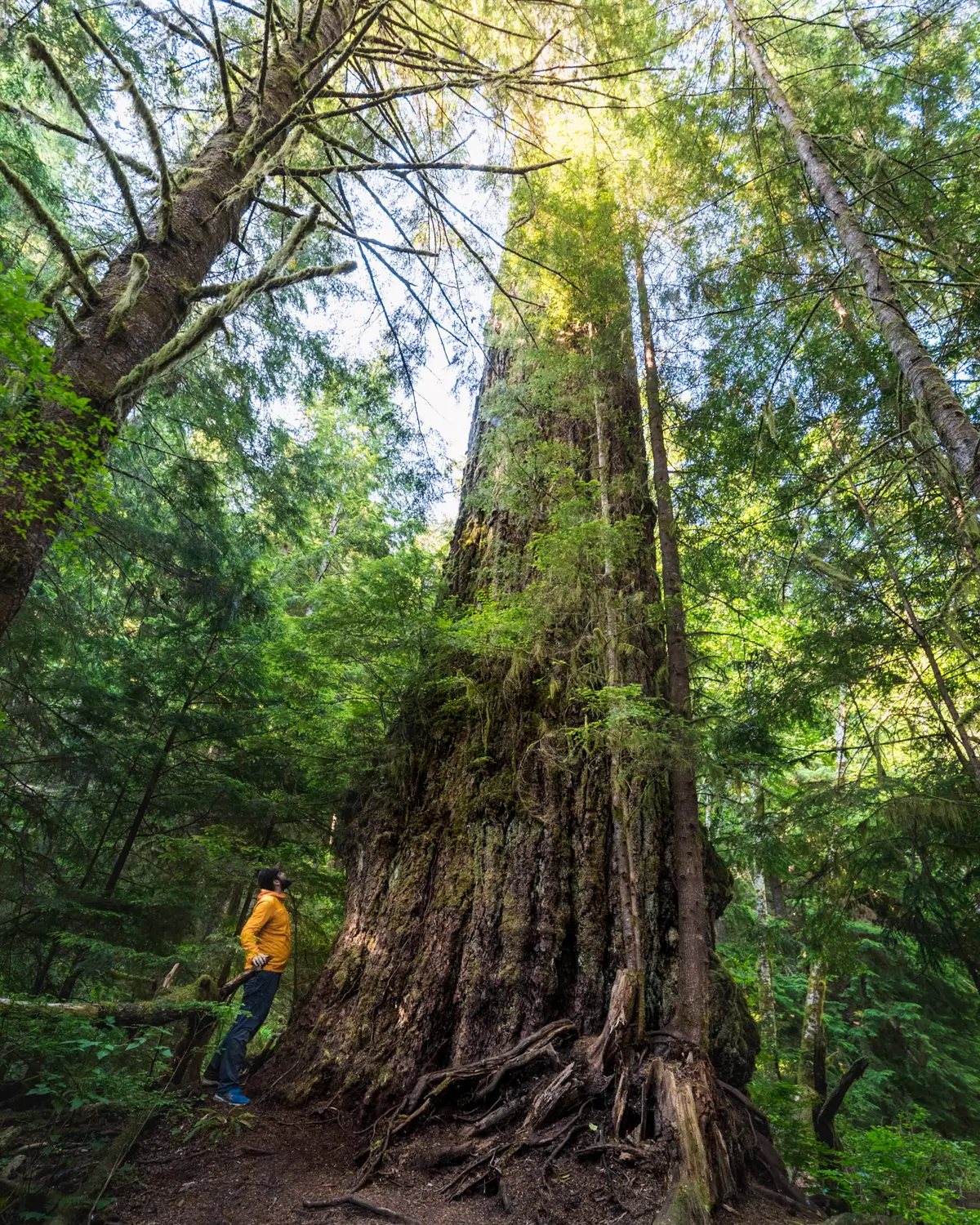
When hiking it’s important to avoid harmful practices such as disturbing plants or rock-stacking, or removing any natural object from flowers to rocks, as it’s important to leave the environment as natural as possible for the animals and for fellow hikers to enjoy in perpetuity. As many flowers as there are, there are few enough that if we all took one, then there wouldn’t be any left. Take only photos, leave only footprints.
If you haven’t heard of Leave No Trace principles, they’re also really essential to read up on before heading anywhere into the outdoors in general. Following these important principles basically means doing your best to leave beautiful places like the Red Creek Fir as good (if not better) than you found them, both for their preservation and for the enjoyment of other visitors.
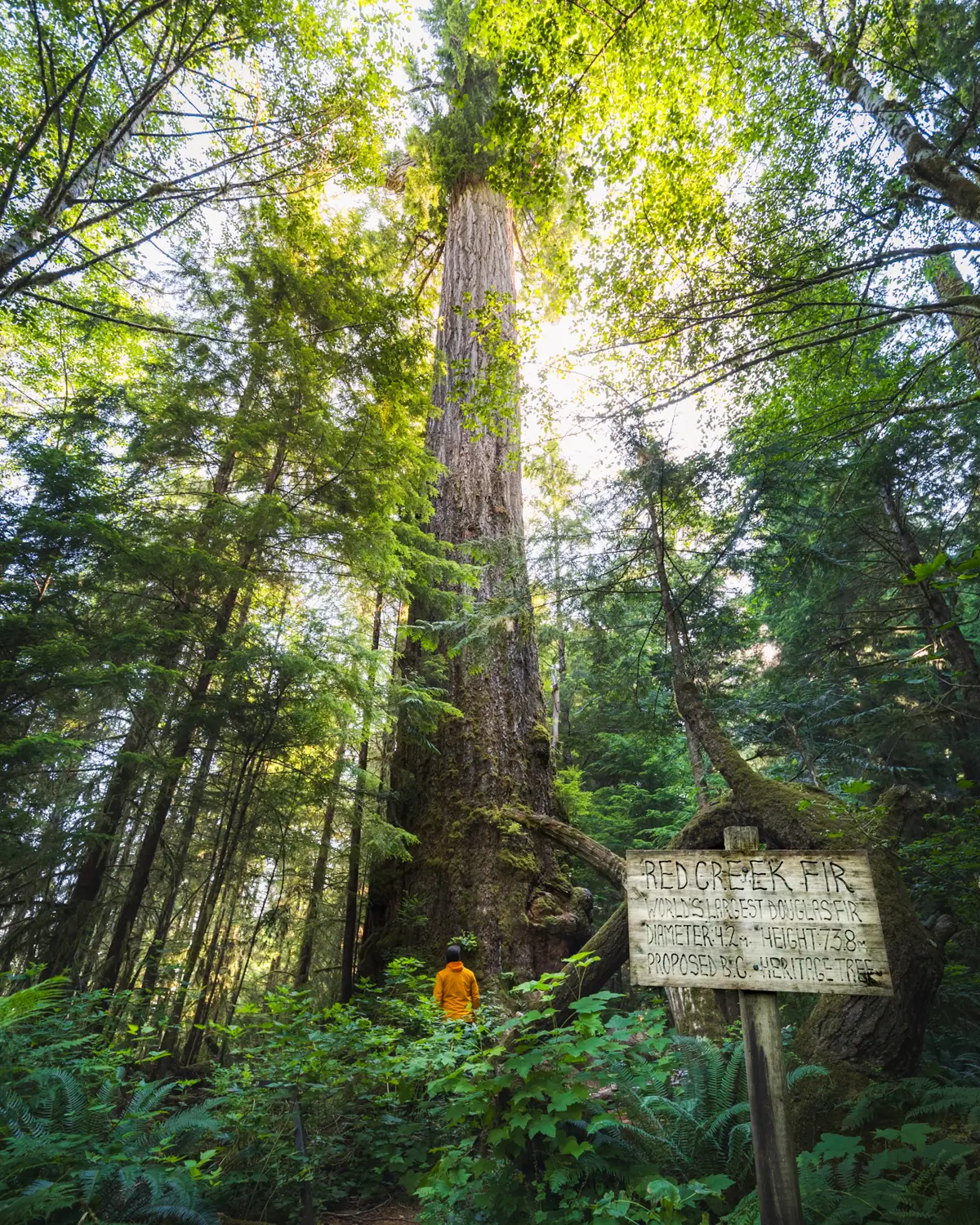
Red Creek Fir Round Trip Details
Distance: 1.4 kM / 0.9 MI
Elevation Gain: 55 m / 180 ft
Hiking Time: 30-40 Mins
Hiking & Safety Tips
- Prepare for the possibility of wildlife encounters. There are almost no grizzly bears on Vancouver Island, but black bears are still common. Bear bells are proven to be an ineffective bear deterrent, and are even actively discouraged by Parks Canada. The best way to let bears know you’re around is simply to use your voice. Make sure to keep a respectful distance from wildlife and never feed the animals. It may seem kind but it doesn’t just kill wildlife and put people in danger, it’s also in many cases illegal.
- Research current trail conditions and make sure you are well-informed about the route before you leave, and assess if it is within your capability. Be aware of what time it gets dark and check the weather forecast. Make sure to tell someone where you’re going and when you expect to return. Every year as more and more people try hiking for the first time, the number of rescues goes up. Being prepared is the best defense.
- Pack everything you need for a successful hike, including enough water and energy-rich snacks. Remember to pack out everything you pack in though – don’t expect to find a convenient garbage can halfway up the trail. Bring appropriate layers (remember you’ll warm up once you start hiking) and sun protection. Hiking poles may be helpful but are not required. In addition to not leaving any garbage on the trail yourself, I highly recommend bringing a garbage bag and collecting any trash that you do see on the trail. You’re guaranteed to make the walk to the Red Creek Fir a more enjoyable experience for the next person.

How to Get to the Red Creek Fir Trailhead
Typically I provide a Google Maps pin for easy navigation to a trailhead, but I have not done so here for a very important reason. If you try to follow Google Maps to the Red Creek Fir it will take you down deactivated and undriveable logging roads. DO NOT use Google Maps to try and reach the Red Creek Fir. As an alternative I suggest using GaiaGPS, which does accurately map the logging roads in the area, and can be used to see the correct route.
The directions for the Red Creek Fir start off the same as for the San Juan Spruce, as the two are located down the same road. From the first main intersection at the start of town in Port Renfrew, turn north onto Deering Road, following signs for Lake Cowichan. Follow Deering Road for 3 km as it crosses a couple of bridges before turning right at a T intersection onto Pacific Marine Road, continuing to follow signs for Lake Cowichan. After just under 13 km of driving the road will split into the asphalt road on the left with a gravel logging road on the right. Straight ahead in the middle of the V is a large yellow caution sign. Turn right here onto Lens Main and follow the logging road for 5 kms. Just after a bridge over the San Juan River you’ll see a turnoff to the left that has been deactivated and dirt piled up on the road, behind which the San Juan Spruce can be found. Drive on for a further 1.2 kms before turning right at a fork onto Mosquito Main. Mosquito Main climbs up along the side of the valley. Be extra vigilant of oncoming logging trucks here, as the gravel road is often narrow and there are plenty of blind corners. Continue along Mosquito Main for 5 kms as it rises up along the side of the valley before descending again. After the long downhill section you’ll reach a fork with Red Creek Main – turn right here and continue for a bit less than a km until you see the wide area for parking. The trail for the Red Creek Fir heads up at right.
Walking to the Red Creek Fir
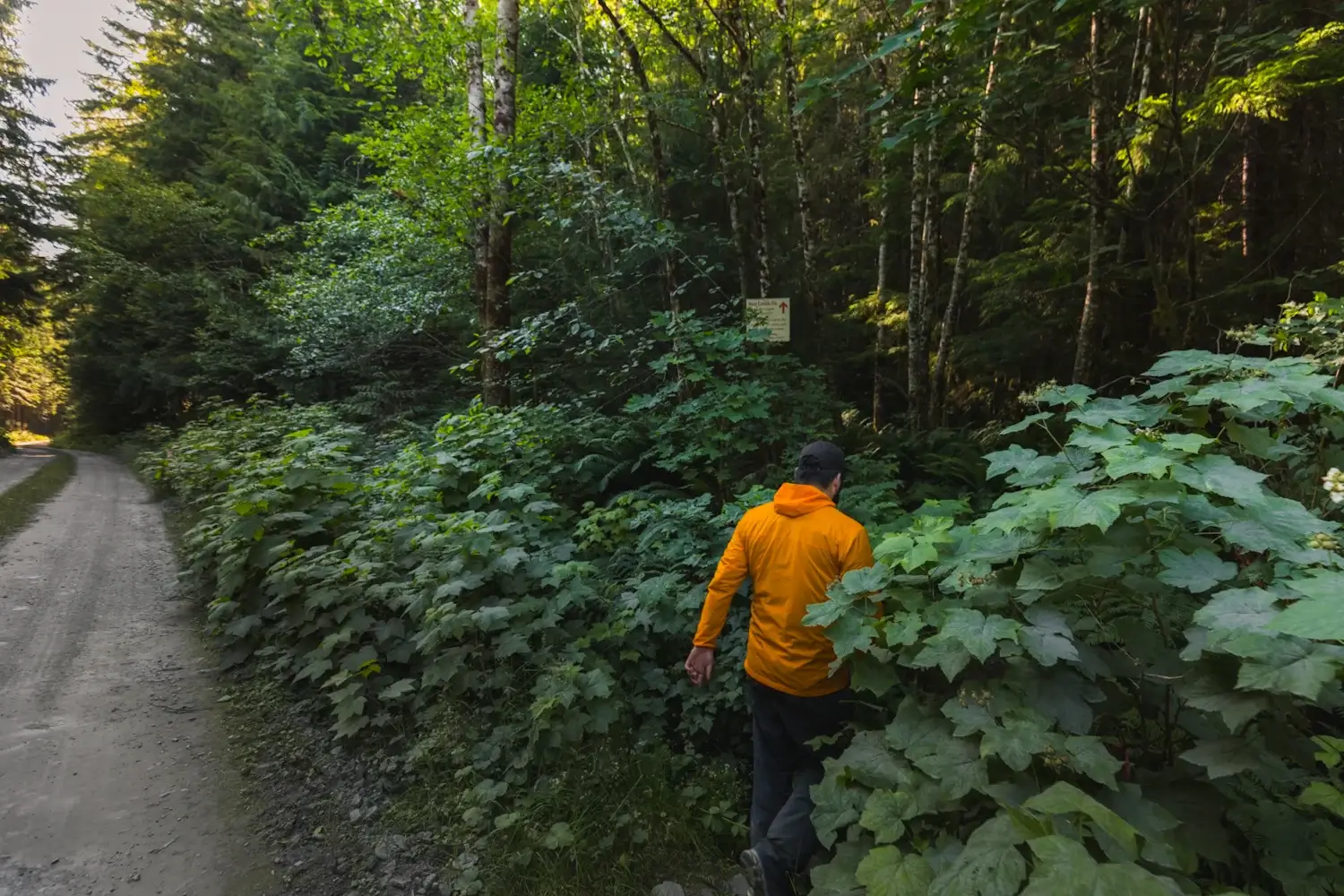
From the side of the logging road, the trail up to the Red Creek Fir starts heading up. Note the trail sign slightly obscured by vegetation.
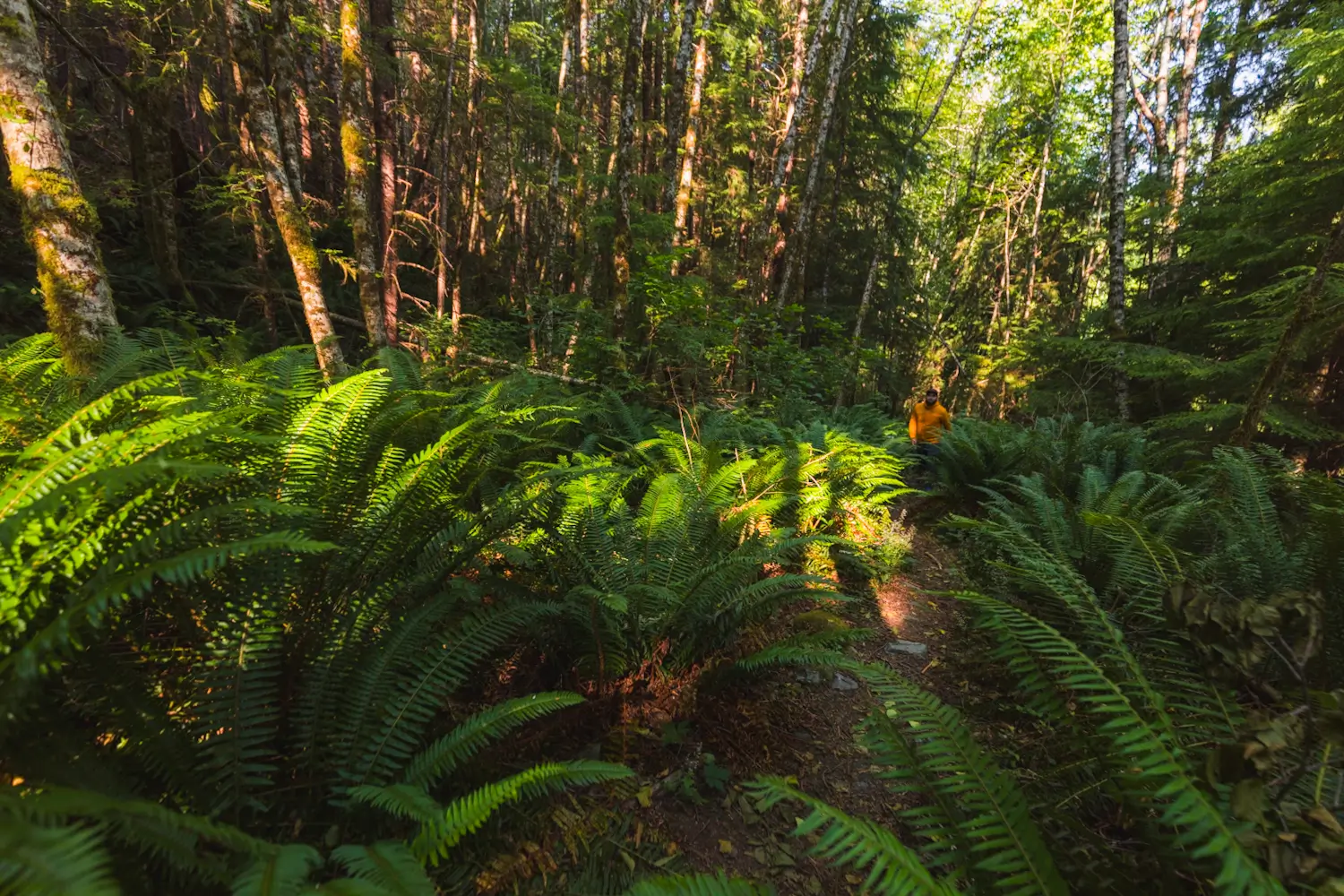
The slightly overgrown trail pushes uphill through some beautiful ferns.
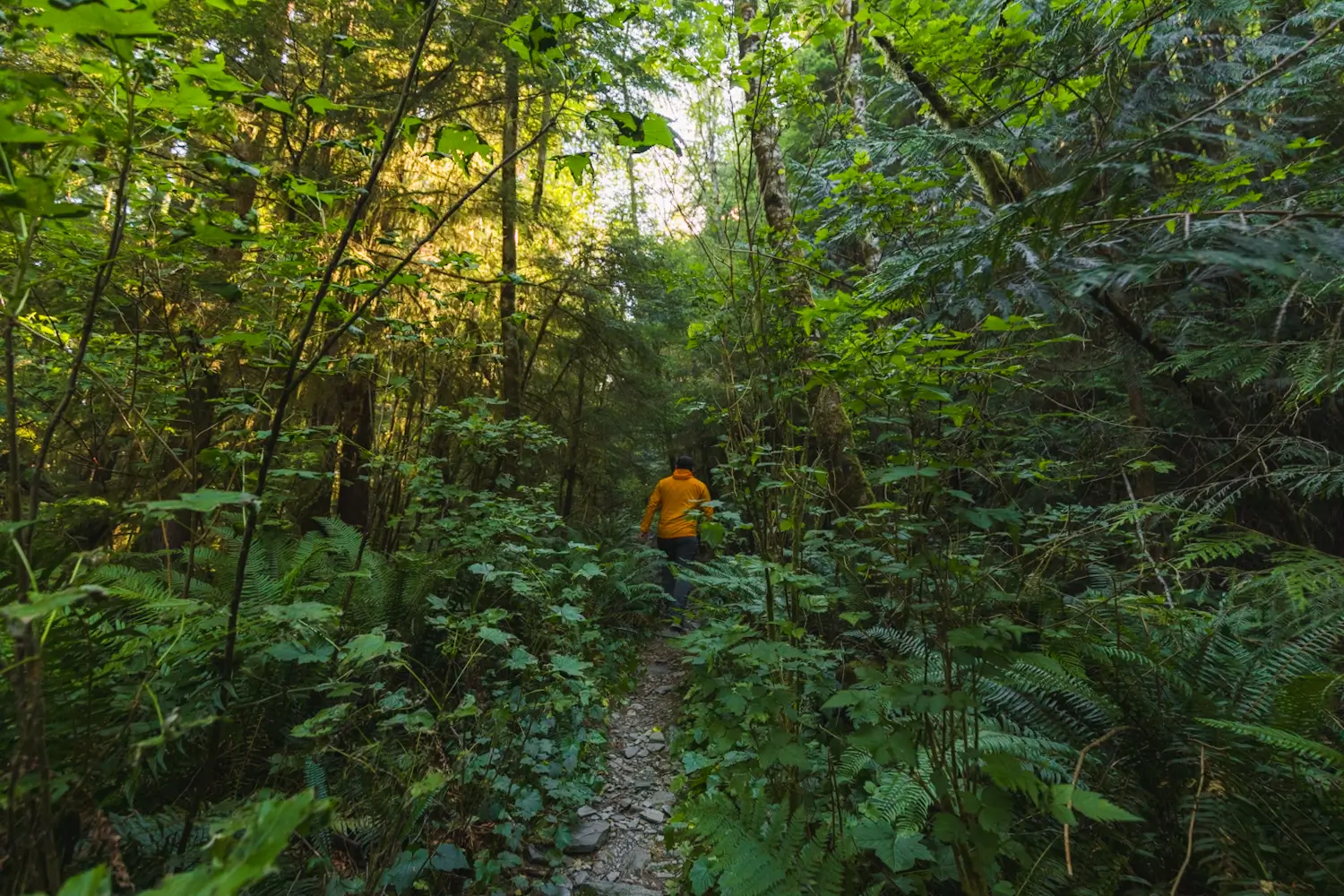
I could tell from the multiple cobwebs I ate that this trail isn’t frequented as often as some others in the area.

The Three Guardians – a trio of huge Western Redcedars along the side of the trail make for a good stop just before reaching the Red Creek Fir.
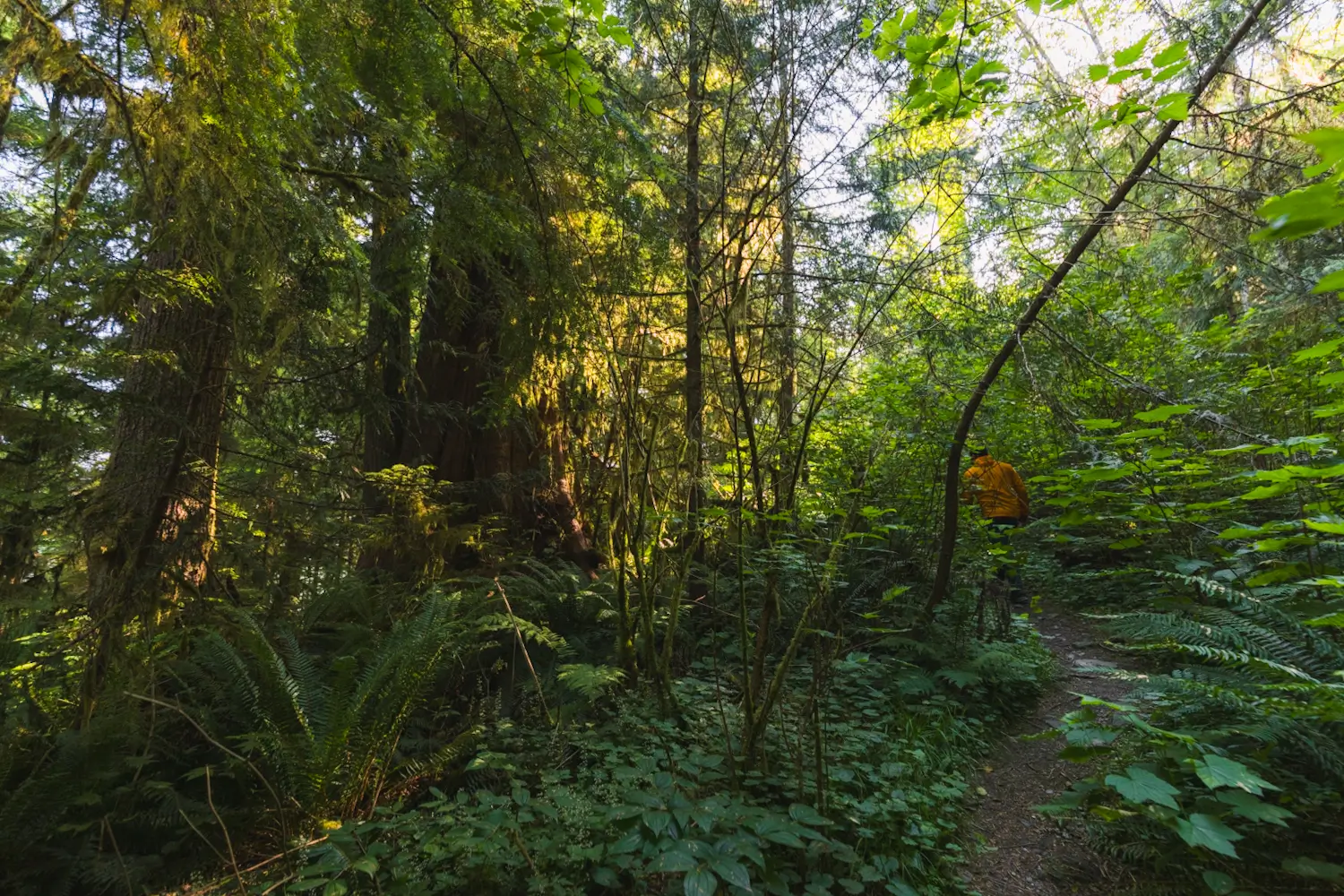
Continuing straight up along the easy to follow trail.
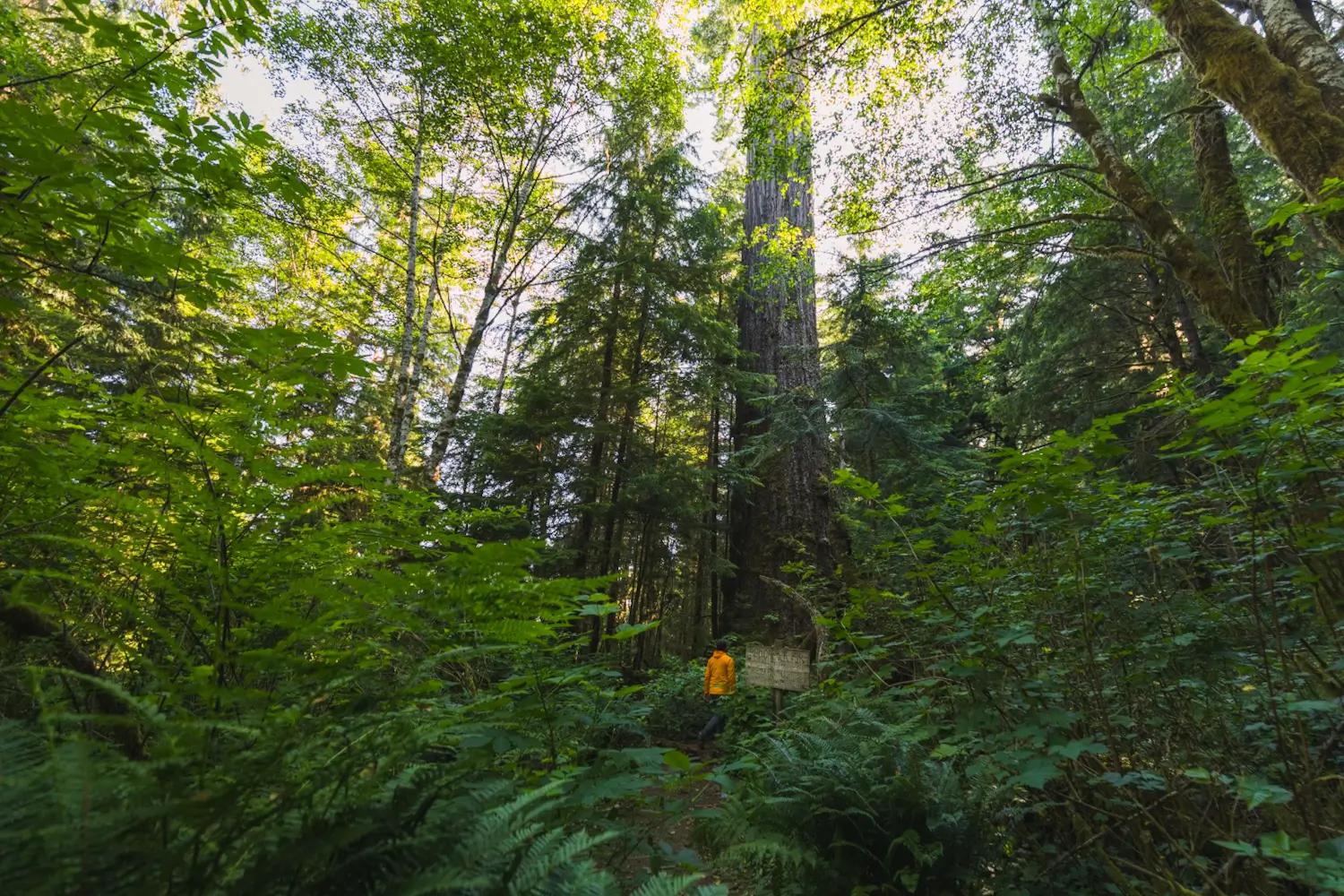
The giant Red Creek Fir is unmistakable from a distance.
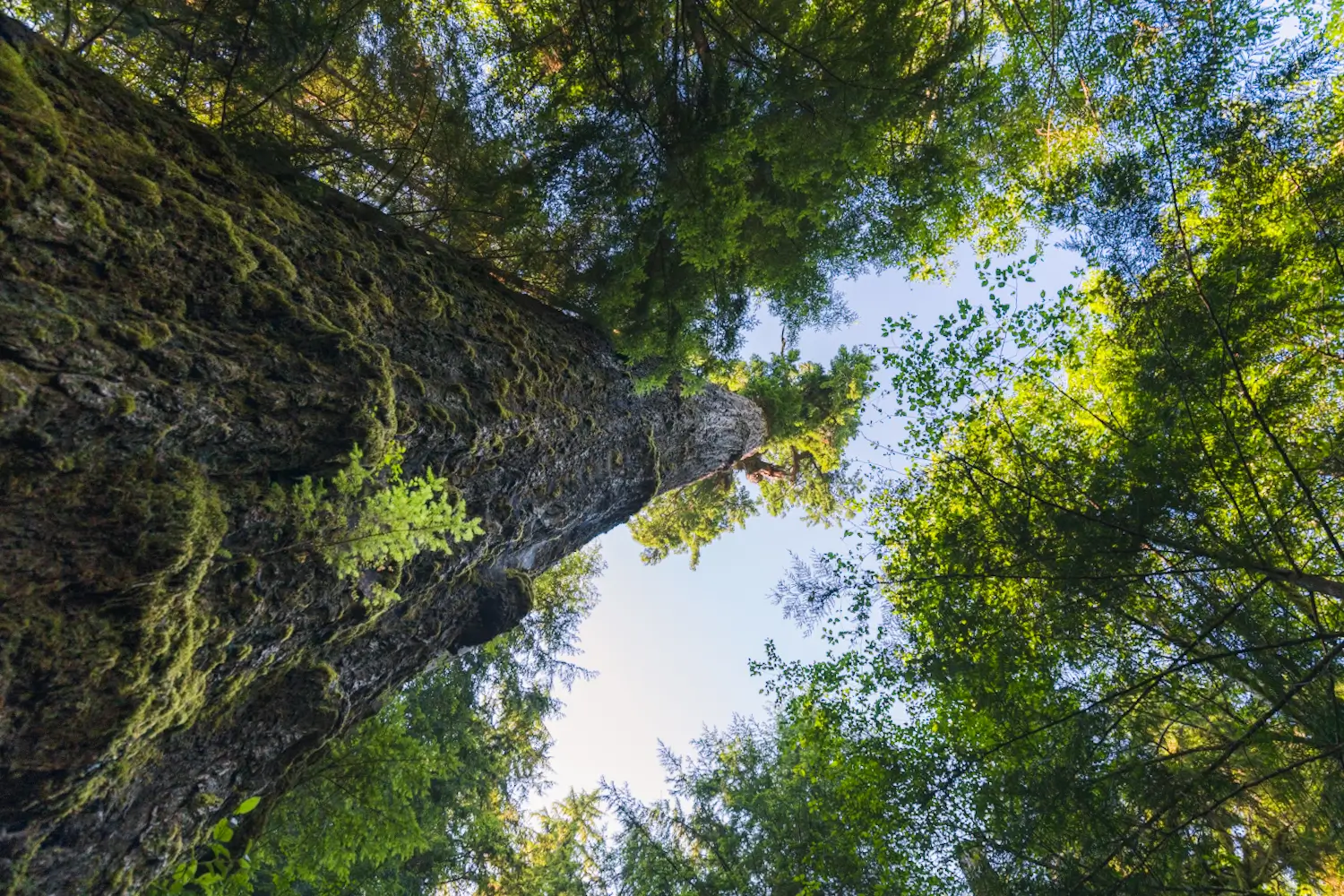
Looking straight up.
Recommended Hiking Gear



Water is a must whenever I’m hiking, especially if the sun is going to be out. My favourite water filter I’ve used is the Katadyn BeFree 0.6L, which unlike other water filters I’ve used packs up really small and lightweight. For hikes where I know there won’t be any readily available water sources along the way, I make sure to bring my own. The Hydrapak Stow 1L bottle is my go-to, for the same reason that it’s made of a soft plastic that folds up and doesn’t take up any more extra space than necessary in my pack. Finally, Aquatabs are another great option for purifying water, with one tablet being suitable for one litre of water. I previously used the Grayl water filter while travelling internationally, and though I found its hard body more convenient for day to day use and easier to drink from, it has a little too much bulk for my fast-and-light style of hiking.



The secret to all my photos of gorgeous sunset and sunrise mountaintop views? A lot of hiking in the dark. And let me speak from personal experience when I say that the last thing that you want to happen when hiking is to be caught in the dark without a headlamp. I used the Black Diamond Spot 400 for years and it worked great – until I lost it on top of a mountain somewhere. The only downside to it was having to worry about the batteries dying, though there’s also a slightly more expensive version that has a rechargeable battery. Nowadays I’m using the Petzl Actik Core, which is a bit pricier than the more budget-friendly Black Diamond, but is also brighter, more comfortable (in my opinion), and has a hybrid power system that is rechargeable but can also take AAA batteries if needed.
You won’t see me using trekking poles on shorter hikes often – but on long hikes and backpacking trips, as well as certain scrambles, they are an absolute lifesaver. I’ve invested in a high quality ultra-lightweight pair of MSR DynaLock Ascent carbon poles which, while pricey, I don’t regret one bit. If you’re not entirely sure how much use you’re going to get out of a pair of trekking poles, the best budget-friendly option would be the Trekology Trek Z 2.0. Amazon does sell a lot of cheaper Made in China-style trekking poles for cheaper, but these usually are much much heavier and not worth buying.
All the best and most long-lasting cables and power banks I’ve ever owned have been Anker. I once had a phone cable from them that lasted me over three years of daily use! That’s why I keep an Anker PowerCore Essential 20K power bank on me. Like many people I use my phone for a lot of stuff when hiking (checking in with family, using online maps, taking photos, flying my drone) so I like to be prepared for that low battery warning by having a backup power source on me just in case.



The only socks I ever buy for myself are from Darn Tough, and I almost always make sure to wear them when hiking. After years of having no problems only wearing these comfortable and rugged socks for hikes, I accidentally wore a pair of no-name socks on a hike last year and ended up with blisters on both feet. Safe to say I’m back to sticking with the Darn Tough. And the best part? They have a lifetime guarantee, meaning that if they ever wear out you can send them back for a brand new pair. For hiking footwear I go between a pair of lightweight approach shoes for quick and dirty mountain ascents or anything involving scrambling and more heavy-duty boots for longer treks. I’ve worn a couple different versions of the lightweight but super durable Arc’teryx Konseal FL 2 approach shoes for a few years now and am very impressed with the durability. I also really like the thick toecap that keeps me protected every time I stumble into a root or large rock. For longer, tougher, or muddier treks I rely on my LOWA Camino EVO GTX, which I find insanely comfortable and made of very high quality.



I wear my Ar’teryx Gamma Lightweight Pants on every single hike I go on, and on many days when I’m not hiking. After several years of abuse they are still holding together extraordinarily well, with only a few small holes from where I’ve fallen down and some slight stains from being repeatedly coated with mud. They’re lightweight, breathable, and super comfortable. For lightweight and breathable hiking tops I’m a big fan of both the Patagonia Capilene Shirt and the MEC Core Shirt. My Arc’teryx Squamish Hoody shows up in a lot of my photos. It’s super lightweight and packable, and does a great job of cutting the wind while also being pretty breathable. I also have an Arc’teryx Atom Hoody and Arc’teryx Beta LT that I pull out for cooler or wetter conditions.
I hope you enjoyed this guide to visiting the Red Creek Fir near Port Renfrew on Vancouver Island! Feel free to leave any questions in the comment section below or to contact me directly via social media.
